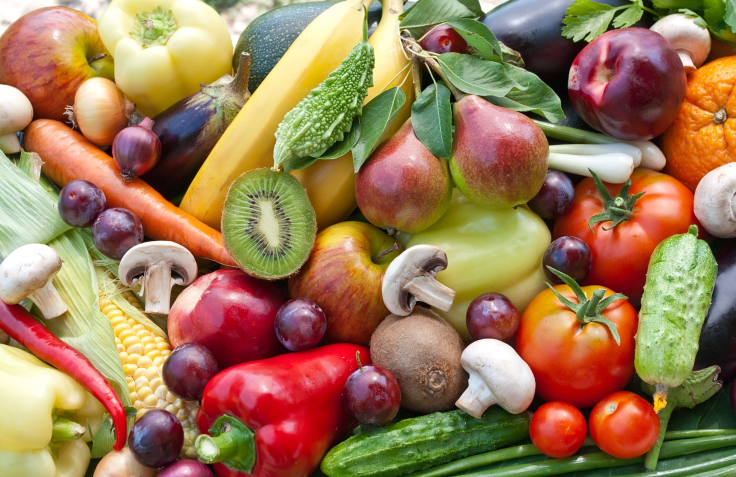In Woody Allen’s “Whatever Works,” Larry David’s character complained in a very Larry David fashion, “Christ, if I have to eat nine servings of fruits and vegetables a day to live, I don’t wanna live.” And he has a point. How the hell are we supposed to chomp down on nine portions of produce each day while still fitting in our protein, grains and occasional guilty pleasures? And what exactly is a “serving” anyway?
We’ve always been told to eat about five servings of fruits and vegetables a day, and a January 2011 study actually suggested it should be eight if you want to seriously lower your risk of dying from heart disease. We’re with you — eight sounds like we’ll need to stuff our pockets with celery stalks and carrots so we can munch on them all day.
The U.S. Department of Agriculture’s dietary guidelines of 2010 recommend eating 2 cups of fruit and 2.5 cups of vegetables a day. (At least they switched to “cups” instead of the pyramid’s mysterious “servings”; for the record, these measurements translate into about nine servings.)
But the Centers for Disease Control and Prevention takes a more individualized approach. After all, our bodies’ requirements must differ with age and lifestyle, right? The CDC offers a calculator that asks for your age, sex and amount of physical activity, and spits out how many fruits and veggies you should be getting each day.
According to the CDC’s calculator, a 26-year-old female with less than 30 minutes of exercise every day — in addition to the light activity of everyday life — requires about 1.5 cups of fruit and 2.5 cups of vegetables each day.
My recommended 4 cups of produce a day might still sound a little overwhelming, but it’s actually not as bad as it seems.
What counts as a fruit or vegetable?
First of all, 1 cup of vegetables doesn’t have to be a heap of raw broccoli. Fruits and veggies can be in the form of 100% juice; raw or cooked; fresh, frozen, canned or dried; and whole, chopped up or pureed. Yes, guacamole counts as a vegetable (score!).
Examples of 1 cup and ½ cup of fruits/veggies
To give you an idea of 1 cup of fruit — or two-thirds of my daily fruit intake — the CDC has provided these examples:
- 1 small apple
- 1 large banana
- 1 medium grapefruit
- 1 large orange
- 1 medium pear
- 1 small wedge watermelon
- 2 large or 3 medium plums
- 8 large strawberries
To get my last ½ cup of fruit, I could (for example) eat:
- 1 snack container of applesauce
- 16 grapes
- 1 medium cantaloupe wedge
- ½ medium grapefruit
- 4 large strawberries
- 1 large plum
- 1 small box (1/4 cup) of raisins
- 1 small banana
To get 2 cups of vegetables, I could eat two of these options:
- 1 large bell pepper
- 1 medium potato
- 2 large stalks of celery
- 1 cup of cooked greens or 2 cups of raw greens (spinach, collards, mustard greens, turnip greens)
- 12 baby carrots (or 2 medium carrots)
- 1 large sweet potato
- 1 large ear of corn
And I can get that last ½ cup of vegetables from a snack of 5 broccoli florets or 6 carrots.
Applying these guidelines to real meals
It’s really easier than you think — and you might already be getting close to the recommended amount. For example, I have a 13.5-fluid-ounce container of orange juice every morning for breakfast. That converts to about 1.7 cups, so I’m already exceeding my daily fruit intake. However, it’s important to note that the Dietary Guidelines of 2010 state that the majority of an individual’s daily fruit intake should come from whole fruit, since 100% fruit juice lacks dietary fiber.
I usually have at least two vegetables with dinner — say, 1 cup of cooked spinach for greens and 1 large sweet potato for a starch — so I knock out four-fifths of my daily vegetable intake in one meal. A snack of one celery stalk with peanut butter in the afternoon would mean I’m consuming my 2.5 cups of vegetables during the day.
A salad for lunch with 1 cup of lettuce and ½ cup of other veggies can help you meet your goal, and try to choose a fresh and nutritious snack instead of a Snickers out of the vending machine during the week. One of my favorites: A tomato, chopped up and salted — preferably with Jane’s Krazy Mixed-Up Salt. Sounds too simple to be so good, but I promise it’s delicious.
Why bother?
Americans fail miserably at getting their fruits and veggies — we only consume an average of three servings a day, or about 1.5 cups.
Meanwhile, science has shown that these healthy foods reduce our risk of cancer and other chronic diseases, such as stroke, Type 2 diabetes and heart disease. Additionally, they provide the vitamins and minerals our bodies need to function — not to mention they’re low calorie and low fat, so they fix your hunger problem without adding to your waistline.
And the more you eat, the better. A 2011 study indicated that each additional portion of fruits and vegetables was linked to a 4% lower risk of death, with one serving defined as 80 grams, the equivalent of a small banana, medium apple or small carrot.
